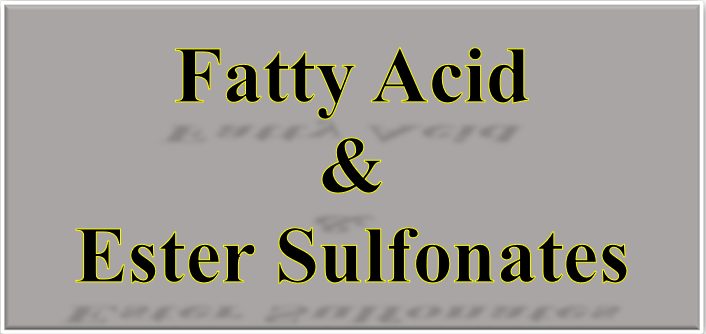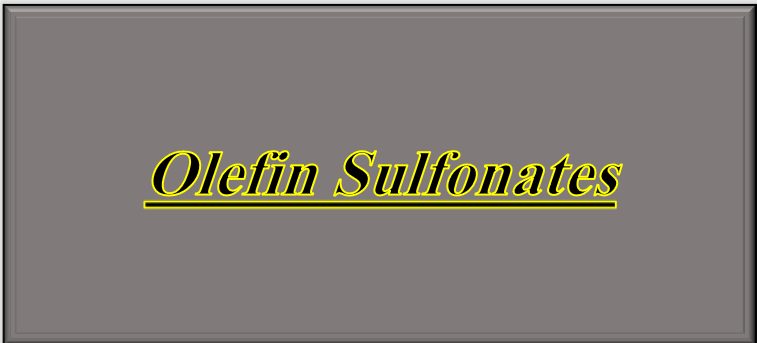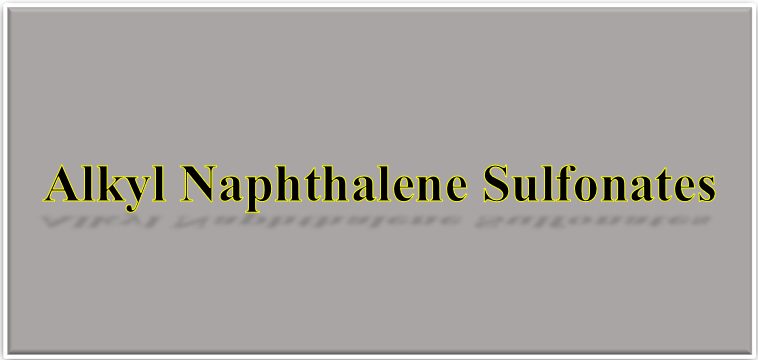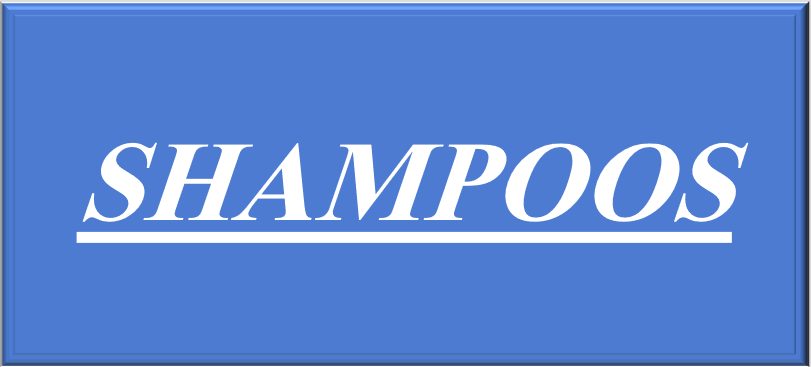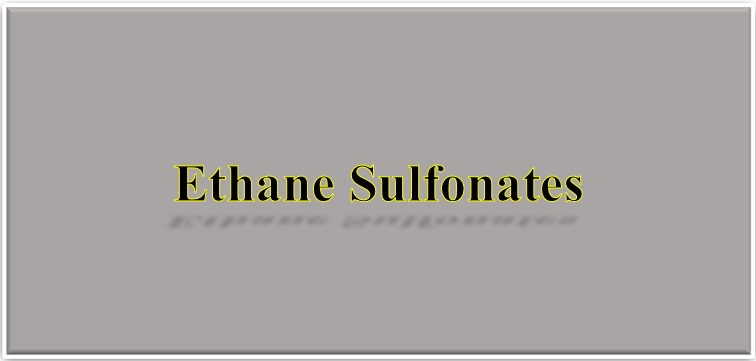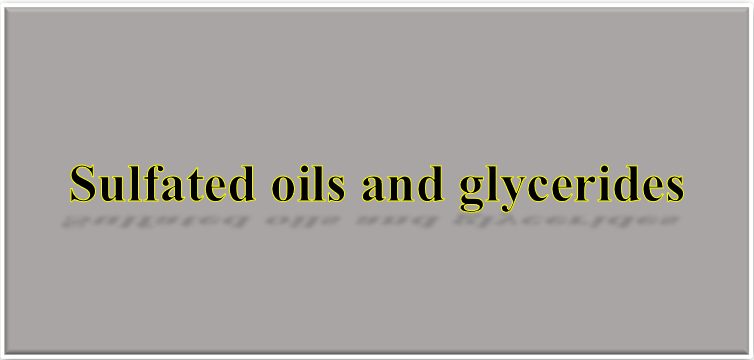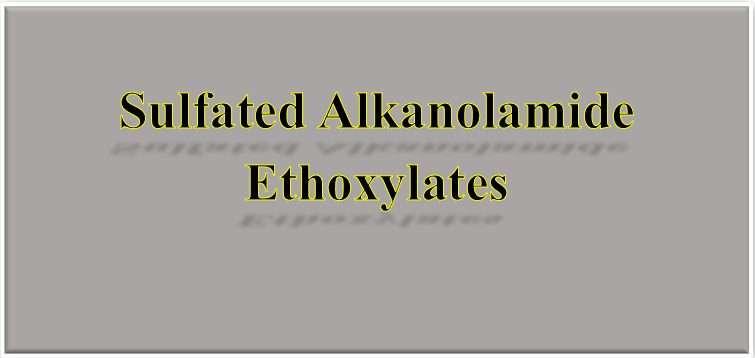General names and abbreviations
There are three types of fatty acid & ester sulfonates:
Type 1. Sulfonated unsaturated acids where the sulfonate group is not near the end of the chain.
General: Sulfonated acids, Example: Sulfonated oleate potassium salt.
Type 2. Salts of alpha-sulfonated fatty esters (or acids). Abbreviations: FES, fatty ester sulfonates, FAS, salts of alpha-sulfonated fatty acids; ES, ester sulfonates.
General: Alpha-sulfonated fatty acids (or esters), Ester sulfonates, Fatty acid sulfonates
Example: Sodium tallow methyl ester alpha-sulfonate.
Type 3. Omega sulfonated fatty acids (or esters).
Description
There are two quite distinct types of sulfonated fatty acids/esters on the market.
Type 1. Sulfonated unsaturated acids
These are produced by the sulfonation of unsaturated fatty acids (or esters). There are not many products of this type available, an example being sulfonated oleic acid. These should not be confused with the sulfated oils and esters have very different properties, The sulfonic acid group is in the middle of the chain, The acid is quite stable but the potassium salt is the normal salt offered for sale due to its higher solubility than the sodium salt.
Type 2. Alpha-sulfonated acids or esters:
The products are available as high-active pastes (50-60% active) but such products often contain added ether sulfates or the salts of short-chain carboxylic acids to facilitate handling.
Sulfonation at the alpha position of the fatty acids does not occur readily due to the weak activation of the carbon atom. Strong sulfonating agents (sulfur trioxide) must be used leading to problems of poor color, particularly if the starting esters have unsaturated groups. The sulfonation reaction is complex. The sodium salt will be a mixture of:
1. The monosodium sulfonate salt of the ester, approx. 80% of the active.
2. The disodium salt of the alpha sulfonated carboxylate, approx. 20% of the active.
3. The sodium salt of the fatty acid produced by hydrolysis of the starting ester which was not sulfonated, i.e. soap approx. 3% of the active.
The properties of these three products are different in solubility, physical properties and surfactant behavior and therefore users should expect differences from one manufacturer to another. However consistent manufacturing conditions should give a consistent material but it would be advisable to check for reproducibility from any manufacturer until confidence in batch-to-batch variation can be established.
The majority of data have been obtained using distilled methyl esters of fatty acids, e.g. tallow fatty acid. However, the presence of some unsaturated triglycerides in the methyl ester seems to have a surprisingly low effect on color and this could well permit the use of undistilled saturated methyl ester for sulfonation in order to reduce costs. Even under optimum sulfonation dark colored products are reported in the literature and special bleaching of the acid and also of the salts is often needed.
Impurities/by-products include disulphonate, soaps and bleaching by-products.
Type 3. Omega ester sulphonates:
These products are different in chemical structure to Types 1 and 2. They are products made by sulfonation of saturated fatty esters using UV radiation as a catalyst. The sulfonic acid group is statistically distributed at random along the chain. They will not be discussed any further because they are not available commercially.
General properties
General
Type 1: excellent wetting; good stability and solubility in high concentrations of electrolytes.
Type 2: excellent cold and hot water detergency in hard water; FES behave in a similar manner to fatty alcohol sulfates with similar chain length but with better hydrolytic stability.
Solubility
Type 1 (sulfonated oleic acid): poor aqueous solubility of acid and sodium salt; potassium salt more soluble.
Type 2: solubility of the salts of C12-C14 FES is excellent but the solubility of the salts of C16-C18 FES is poor compared to other detergent sulfonates. Salts of the disulfonate will tend to crystallize out of solution. Commercial products can be solubilized with hydrotropes.
Chemical stability
Type 2: The principal active product is the sulfonate of a methyl ester of a fatty acid which would be expected to be hydrolytically unstable. However, it is claimed that the methyl ester is stable between pH 3 and 9.5 at 80°C. The product is stable in a neutral detergent and minimal hydrolysis occurs in spray drying of a slurry containing FES and storing at 60°C for some months.
Compatibility with aqueous ions
Type 2: Shows excellent sequestration of hard water in the presence of soap, i.e. lime soap dispersion; thus soap as an impurity could be beneficial.
Viscosity behavior
Type 2: The addition of the disodium salts of FES (acid), particularly C10-C12, can lower the viscosity of LABS, soap, alkyl sulfates, ether sulfates and FES; this can be utilized in reducing the viscosity of slurries for spray drying.
Functional properties
Type 2: Foaming properties are better with C12-C14 than with C16-C18 fatty acids; thus alpha-sulfo methyl tallowate gives low foam. C16-C18 based detergents showed superior detergency to LABS in the absence of polyphosphates at low concentration and at high water hardnesses. Soil-suspending power is good, but foam is too high in horizontal washing machines although foam problems are not encountered with C12-C14 which is unexpected. Some doubt on fabric incrustation in the complete absence of polyphosphates.
Applications
Type 1: Wetting agent particularly in high pH solutions and high concentrations of electrolyte; gives very low foam compared to most other anionics of similar wetting properties; applications in textile processing, metal cleaning, industrial detergents, emulsion polymerization.
Type 2: Excellent detergency with good lime soap dispersability, particularly phosphate-free detergents can be manufactured to give excellent performance if soap is included; optimum detergency found at C16-C18 fatty acids (with the methyl ester); used in synthetic soap bars with cocomonoethanolamide and inorganic builders and as an emulsifier for emulsion polymerization (PVC).

